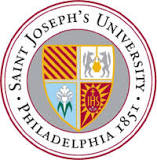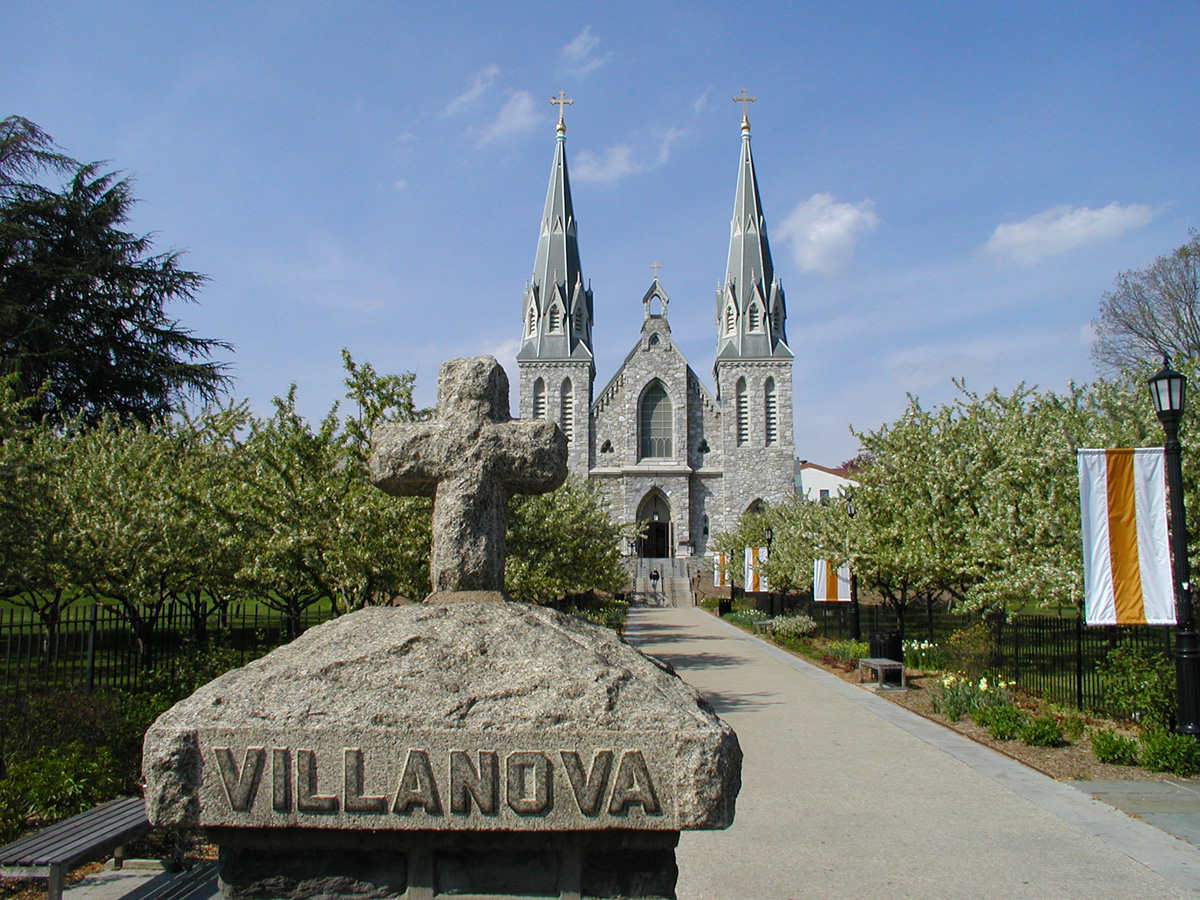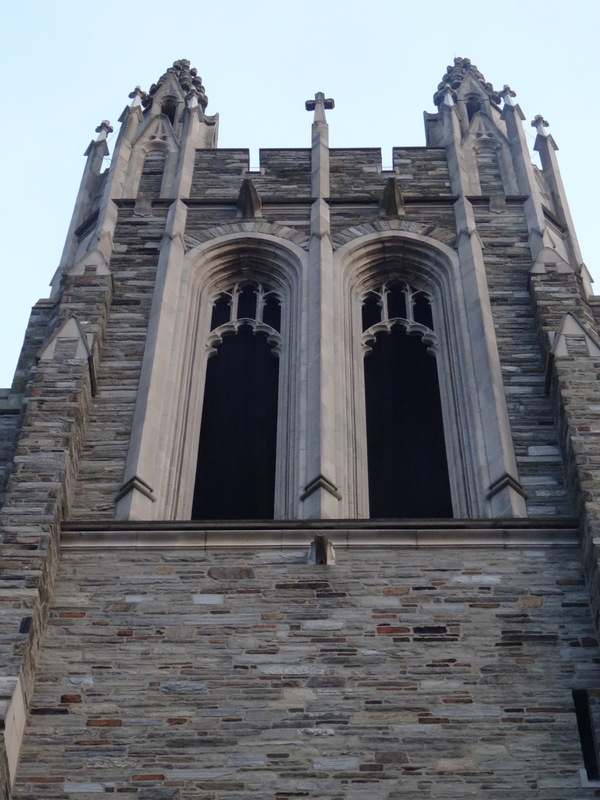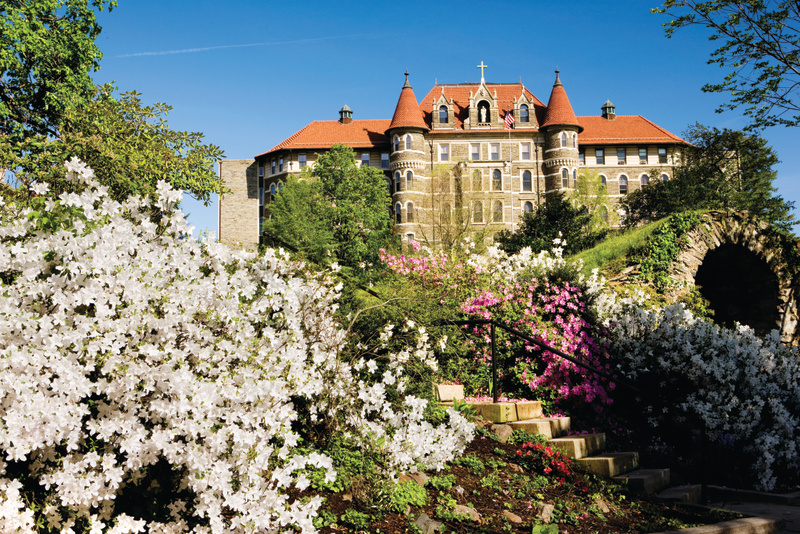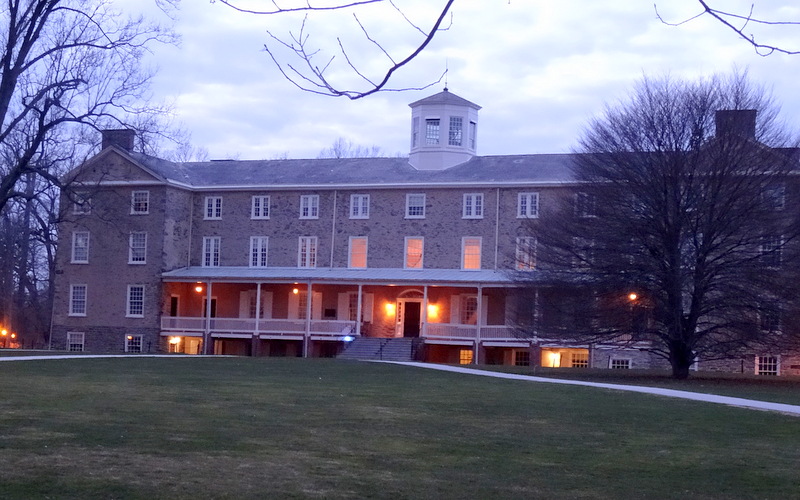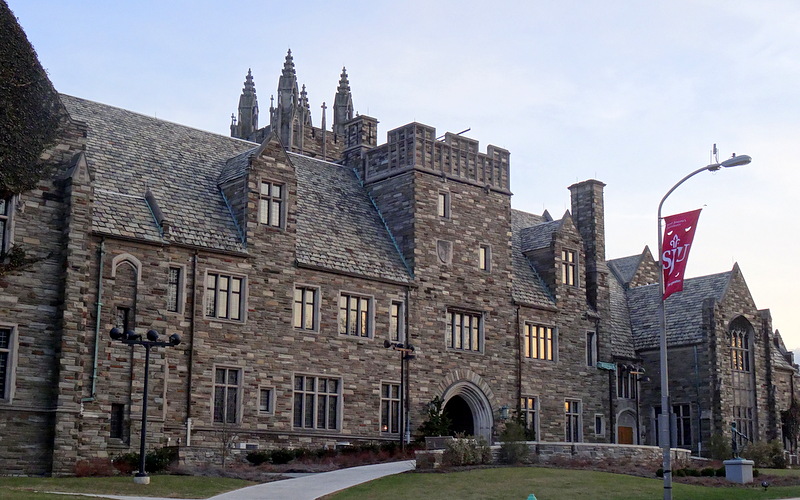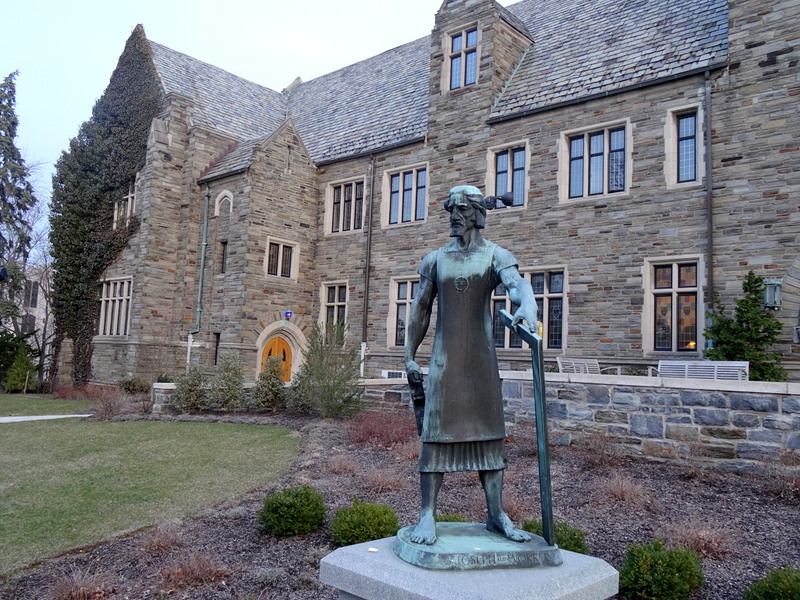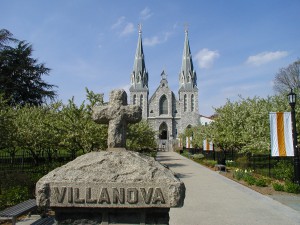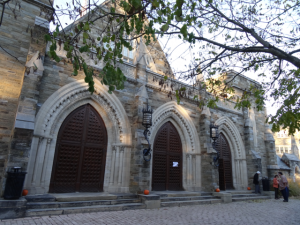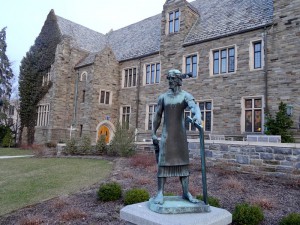Higher Education: Private (Religious)
Essay
With the exception of Greater Boston, the Philadelphia region has more independent colleges and universities than any other metropolitan area of the United States. These numbers stem in large part from the variety of religious communities in the region, all of whom wanted to enjoy the prestige of having an institution of higher learning. Originally, both Catholic and Quaker institutions wanted to offer a “protected education” that would keep their young people away from “false teachings” and worldly temptations.
The religious connections of colleges and universities have taken several forms. In the case of Protestant institutions, there has commonly been sponsorship or affiliation with a particular denomination; and in the case of Catholic institutions, with a religious order of priests, sisters, or brothers. Over time, Protestant connections have tended to become weaker and then nonexistent, while the Catholic affiliations have remained.
In addition to providing a protected education, Catholic religious orders, both male and female, historically viewed their schools as opportunities for identifying possible candidates to join their communities, much as the early Protestant colleges hoped to attract students to the ministry. The more successful graduates of Catholic colleges, as well as other religiously sponsored institutions of higher learning, might also enhance the reputations of the sponsoring religious groups and provide future financial support. Initially, nearly all these colleges were single-sex institutions, but by the early twenty-first century all but one in the Greater Philadelphia region had become coeducational. Several had also attained university status.
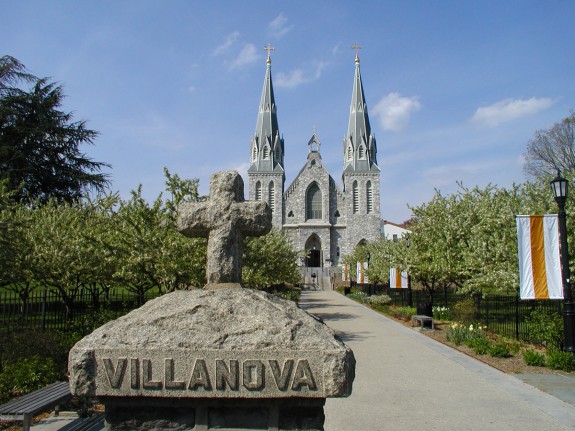
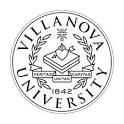 The first of the Catholic men’s colleges was Villanova. In part because of strong anti-Catholicism (or nativism) in Philadelphia in the 1840s, a small band of Augustinians founded the college approximately twelve miles west of the city, on a large estate they had purchased the year before in what would come to be known as the Main Line suburbs. They placed the property under the patronage of Saint Thomas of Villanova, a sixteenth-century Spanish Augustinian; who was also Archbishop of Valencia. He had been born near the Spanish village of Villanueva, which in Latin became Villanova. In time, the local railroad station, post office, and residential development around the college also took this name.
The first of the Catholic men’s colleges was Villanova. In part because of strong anti-Catholicism (or nativism) in Philadelphia in the 1840s, a small band of Augustinians founded the college approximately twelve miles west of the city, on a large estate they had purchased the year before in what would come to be known as the Main Line suburbs. They placed the property under the patronage of Saint Thomas of Villanova, a sixteenth-century Spanish Augustinian; who was also Archbishop of Valencia. He had been born near the Spanish village of Villanueva, which in Latin became Villanova. In time, the local railroad station, post office, and residential development around the college also took this name.
Residential Requirement
At first, Villanova’s distance from Philadelphia—or any other centers of population—made living on campus a practical necessity, an arrangement that has persisted, partly out of tradition, to the present day. For several reasons, the college closed twice in the early years, the first time for a year (1845-1846), the second time for eight (1857-1865). During these precarious times, few could have imagined that, in 1953, Villanova would achieve university status, or that in 1968, after more than a century as an all-male college, it would open its academic programs to both men and women, becoming the first Catholic institution of higher learning in the area to do so.
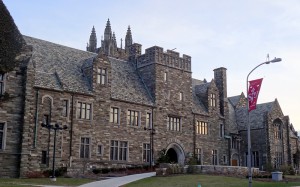
Nine years after Villanova opened its doors, Jesuits in Philadelphia established Saint Joseph’s College on their property at Old St. Joseph’s Church, located in Willings Alley between Third and Fourth Streets, and Walnut and Locust Streets. In 1856, the college moved to a building at Juniper and Filbert Streets but had to sell it three years later because of heavy debt. The college moved back to Willings Alley, but it could not attract enough students to stay afloat and closed about 1870. It reopened in 1889 at Seventeenth and Stiles Street, next to the massive, Baroque-style Church of the Gesu. The college moved to its fourth and current site, at Fifty-Fourth Street and City Avenue, in 1927. Located at the boundary between Philadelphia and the Main Line suburbs, Saint Joseph’s had no residence halls at first and remained entirely a commuter school for several decades. Saint Joseph’s became a coeducational institution in 1970 and achieved university status in 1978.
 The third Catholic men’s college to be founded was La Salle, chartered in 1863 by the Christian Brothers and named for the founder of their order, St. John Baptiste de La Salle. The first classes met at St. Michael’s parish school at 1421 Second Street. In 1867, the college purchased the same building at Juniper and Filbert Streets that Saint Joseph’s had been forced to sell. La Salle’s happier experience at the site probably owed something to the return of peace and prosperity following the Civil War, but its success where Saint Joseph’s had failed must have embarrassed the Jesuits. Because of overcrowding, in 1886 La Salle moved to a new campus at Broad and Stiles Streets, only four blocks east of the site where the Jesuits were planning to open Saint Joseph’s College. The Christian Brothers worried about the proximity but went ahead after considerable debate. In 1930, La Salle built a new campus on the eastern edge of the Germantown section of Philadelphia at Twentieth Street and Olney Avenue, in a largely working-class neighborhood. La Salle admitted women in 1970 and in 1984 became a university.
The third Catholic men’s college to be founded was La Salle, chartered in 1863 by the Christian Brothers and named for the founder of their order, St. John Baptiste de La Salle. The first classes met at St. Michael’s parish school at 1421 Second Street. In 1867, the college purchased the same building at Juniper and Filbert Streets that Saint Joseph’s had been forced to sell. La Salle’s happier experience at the site probably owed something to the return of peace and prosperity following the Civil War, but its success where Saint Joseph’s had failed must have embarrassed the Jesuits. Because of overcrowding, in 1886 La Salle moved to a new campus at Broad and Stiles Streets, only four blocks east of the site where the Jesuits were planning to open Saint Joseph’s College. The Christian Brothers worried about the proximity but went ahead after considerable debate. In 1930, La Salle built a new campus on the eastern edge of the Germantown section of Philadelphia at Twentieth Street and Olney Avenue, in a largely working-class neighborhood. La Salle admitted women in 1970 and in 1984 became a university.
Although there was no need for a third Catholic college in or around Philadelphia, the sponsoring Catholic orders all worried that failing to start their own college would give rival orders an advantage in identifying and recruiting members. At a time when neither national nor state authorities exercised much control over higher education, almost any would-be college founders could obtain a charter of incorporation from their state legislatures. Under the circumstances, it is not surprising that of the forty Catholic colleges founded in the United States before 1850, only ten still existed a century later. For a few precarious years it looked as if both Villanova and Saint Joseph’s would be among the casualties.
The Catholic Mandate
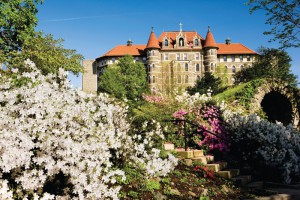
Catholic authorities in Philadelphia strongly discouraged and then forbade their youth attending non-Catholic colleges and universities. In 1927, then Cardinal Dennis Dougherty (1865-1951) wrote, “If a parish school be necessary in the lower grades, it is still more necessary in the higher; because it is in the higher grades that history, literature, and the experimental sciences are taught in connection with which theories are advanced in non-Catholic universities, colleges, and high schools . . . that are dangerous to Religion.” Dougherty’s successor, Cardinal John O’Hara, made the ban official. Throughout their episcopates, Catholic high schools and academies routinely refused to send students’ transcripts to non– Catholic institutions of higher learning.
 Requiring attendance at Catholic institutions was clearly a boon to Villanova, Saint Joseph’s, and La Salle. At the same time, the archdiocese, along with the church as a whole, firmly opposed coeducation. This stance meant that Catholic women had to attend single-sex institutions. To meet the need, three now “historic”
Requiring attendance at Catholic institutions was clearly a boon to Villanova, Saint Joseph’s, and La Salle. At the same time, the archdiocese, along with the church as a whole, firmly opposed coeducation. This stance meant that Catholic women had to attend single-sex institutions. To meet the need, three now “historic”  Catholic women’s colleges—Immaculata College, Rosemont College, and Chestnut Hill College—were founded within three years of one another in the 1920s, a time when college enrollments of women were rising all over the country. The three women’s colleges flourished for the next half century, in no small measure because of the archdiocese’s insistence on women attending single-sex Catholic institutions. In the second half of the twentieth century, women’s religious orders also
Catholic women’s colleges—Immaculata College, Rosemont College, and Chestnut Hill College—were founded within three years of one another in the 1920s, a time when college enrollments of women were rising all over the country. The three women’s colleges flourished for the next half century, in no small measure because of the archdiocese’s insistence on women attending single-sex Catholic institutions. In the second half of the twentieth century, women’s religious orders also 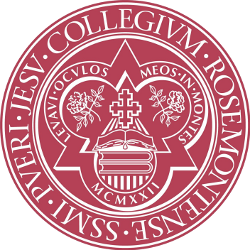 opened Gwynedd Mercy College, Holy Family College, Neumann College, and Cabrini College. Catholic women’s colleges provided an education that was thought to be doubly sheltered, as women were protected from ideas that might undermine their faith, at the same time as their moral virtue was being protected from temptations resulting from coeducation.
opened Gwynedd Mercy College, Holy Family College, Neumann College, and Cabrini College. Catholic women’s colleges provided an education that was thought to be doubly sheltered, as women were protected from ideas that might undermine their faith, at the same time as their moral virtue was being protected from temptations resulting from coeducation.
Nevertheless, Catholic colleges and universities followed the wave of coeducation in the United States. The change began at Villanova, where students insisted on it as part of other reforms in line with the demands for gender and racial equality in the 1960s. Once Villanova admitted women to all its programs in 1968, Saint Joseph’s and La Salle had to follow suit or risk declining enrollments. But because the perception persisted that Catholic women were better served socially and academically by single-sex institutions, the Catholic women’s colleges in the region—with the exception of Cabrini, which went coed in 1970— waited another generation to admit men.
In addition to the Catholic institutions, the Religious Society of Friends (or Quakers) founded two colleges, Haverford and Swarthmore, and was very influential in the founding of Bryn Mawr College. Swarthmore and Haverford, the earliest of the three, were relative late-comers among Protestant colleges, in part because Quakers, with no need for clergy, did not have to establish colleges to attract and educate men for the ministry.
Quaker Split
 Haverford College emerged from a crisis in 1827 when the Religious Society of Friends split between the Orthodox and Hicksite branches. The Orthodox Quakers, who were generally wealthier and more urbane than the more agrarian and poorer Hicksites, wanted to bring their society into the mainstream of American Protestantism. One way to do that was to found a college for “an enlarged and liberal system of instruction in the Society of Friends.” Wealthy Orthodox Quakers from both Philadelphia and New York City subscribed funds to found what became Haverford College, which opened in 1833, in Haverford Township about ten miles west of Philadelphia.
Haverford College emerged from a crisis in 1827 when the Religious Society of Friends split between the Orthodox and Hicksite branches. The Orthodox Quakers, who were generally wealthier and more urbane than the more agrarian and poorer Hicksites, wanted to bring their society into the mainstream of American Protestantism. One way to do that was to found a college for “an enlarged and liberal system of instruction in the Society of Friends.” Wealthy Orthodox Quakers from both Philadelphia and New York City subscribed funds to found what became Haverford College, which opened in 1833, in Haverford Township about ten miles west of Philadelphia.
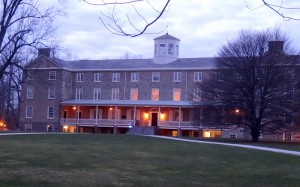
Much like the early Catholic colleges in the region, Haverford sought to provide a “guarded education,” with, at first, all students and faculty belonging to the Quaker religion, “so as not to endanger their religious principles or alienate them from the early attachments.” Cardinal Dougherty, who later insisted on a guarded education for the members of his flock, could not have said it better. By the twenty-first century, the great majority of students and faculty at Haverford were not Quaker, and there was no attempt to restrict inquiry to Quaker views of the world, though Quaker social principles continued to influence the institution. In 1980, Haverford admitted women to all its programs for the first time.
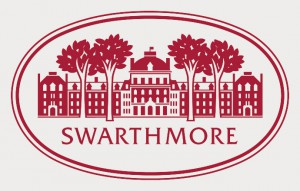 Not to be outdone, the Hicksite Quakers founded Swarthmore College in 1864, locating it in Delaware County, eleven miles southwest of Philadelphia. The site conformed to their desire to situate the college in a “rural district with convenient access to the city of Philadelphia, where the beauty and simplicity of our Christian profession” could be blended into the atmosphere. The college was named for Swarthmore Hall, the home in England of George Fox, the founder of Quakerism. Swarthmore’s founders engaged actively in the abolitionist and women’s rights movements; and Swarthmore, unlike Haverford, admitted both men and women from the beginning. Again, in contrast to Haverford in its early years, Swarthmore did not restrict enrollment to Quakers. For several decades Swarthmore remained a small and relatively undistinguished college. This situation changed when Frank Aydelotte (1880-1956) became the college’s first non-Quaker president in 1920. He attracted one of the best college faculties in the nation and made Swarthmore a top-flight liberal arts college.
Not to be outdone, the Hicksite Quakers founded Swarthmore College in 1864, locating it in Delaware County, eleven miles southwest of Philadelphia. The site conformed to their desire to situate the college in a “rural district with convenient access to the city of Philadelphia, where the beauty and simplicity of our Christian profession” could be blended into the atmosphere. The college was named for Swarthmore Hall, the home in England of George Fox, the founder of Quakerism. Swarthmore’s founders engaged actively in the abolitionist and women’s rights movements; and Swarthmore, unlike Haverford, admitted both men and women from the beginning. Again, in contrast to Haverford in its early years, Swarthmore did not restrict enrollment to Quakers. For several decades Swarthmore remained a small and relatively undistinguished college. This situation changed when Frank Aydelotte (1880-1956) became the college’s first non-Quaker president in 1920. He attracted one of the best college faculties in the nation and made Swarthmore a top-flight liberal arts college.
Bryn Mawr’s Leap Forward
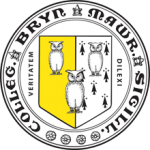 Bryn Mawr College, which opened in 1885, originally was conceived as a “female Haverford” by its board of trustees, most of whom were Quakers. M. Carey Thomas (1857-1935), Bryn Mawr’s second president, grew up as a Quaker, but she insisted that Bryn Mawr had to identify with contemporary life and thought, rather than with restrictive Quaker traditions, if it were to offer women an education equivalent to that offered by the best all-male colleges. She hired men as well as women to the faculty and built an English-style quadrangle campus complete with sumptuous Gothic Revival buildings. She also loved theater and pageantry, and by 1900 Bryn Mawr was well known for its elaborate Elizabethan May Day festivals, which were about as far removed from the simplicities of Quakerism as one could imagine. By the twenty-first century, Bryn Mawr was the only private college in the area that maintained its single-sex status, but it entered into an agreement with Haverford and Swarthmore, both coeducational institutions, to allow students to take courses at any of the three colleges.
Bryn Mawr College, which opened in 1885, originally was conceived as a “female Haverford” by its board of trustees, most of whom were Quakers. M. Carey Thomas (1857-1935), Bryn Mawr’s second president, grew up as a Quaker, but she insisted that Bryn Mawr had to identify with contemporary life and thought, rather than with restrictive Quaker traditions, if it were to offer women an education equivalent to that offered by the best all-male colleges. She hired men as well as women to the faculty and built an English-style quadrangle campus complete with sumptuous Gothic Revival buildings. She also loved theater and pageantry, and by 1900 Bryn Mawr was well known for its elaborate Elizabethan May Day festivals, which were about as far removed from the simplicities of Quakerism as one could imagine. By the twenty-first century, Bryn Mawr was the only private college in the area that maintained its single-sex status, but it entered into an agreement with Haverford and Swarthmore, both coeducational institutions, to allow students to take courses at any of the three colleges.
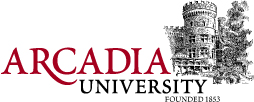 Other Protestant denominations also opened colleges in the Philadelphia region beginning in the mid-nineteenth century. What became Arcadia University was originally a women’s college, established under Methodist Church auspices in 1853 as a “female seminary” in Beaver County, located in extreme western Pennsylvania. It became a coeducational college in 1876, but returned to being an all-women’s college in 1907. Financial difficulties caused the college to relocate in 1925 to the Philadelphia suburb of Jenkintown, where it merged with the Beechwood School, a preparatory school and junior college. With the move, it severed connections with the Methodist Church, but soon after relocating to Jenkintown it affiliated with the Presbyterian Church. In 1927, the college purchased a former estate of William Welsh Harrison, known as “Gray Towers,” in nearby Glenside and operated on both sites until 1962, when it shifted all its programs to the Glenside campus. In 1973, at a time of falling enrollment, the college returned to being a coeducational institution. In 2000, Beaver College became Arcadia University. Its large graduate programs together with the negative connotations of the word “beaver,” which were depressing undergraduate inquiries and enrollment, moved the trustees to change the school’s name and seek university status.
Other Protestant denominations also opened colleges in the Philadelphia region beginning in the mid-nineteenth century. What became Arcadia University was originally a women’s college, established under Methodist Church auspices in 1853 as a “female seminary” in Beaver County, located in extreme western Pennsylvania. It became a coeducational college in 1876, but returned to being an all-women’s college in 1907. Financial difficulties caused the college to relocate in 1925 to the Philadelphia suburb of Jenkintown, where it merged with the Beechwood School, a preparatory school and junior college. With the move, it severed connections with the Methodist Church, but soon after relocating to Jenkintown it affiliated with the Presbyterian Church. In 1927, the college purchased a former estate of William Welsh Harrison, known as “Gray Towers,” in nearby Glenside and operated on both sites until 1962, when it shifted all its programs to the Glenside campus. In 1973, at a time of falling enrollment, the college returned to being a coeducational institution. In 2000, Beaver College became Arcadia University. Its large graduate programs together with the negative connotations of the word “beaver,” which were depressing undergraduate inquiries and enrollment, moved the trustees to change the school’s name and seek university status.
 In 1869 the German Reformed Church (later the United Church of Christ) opened Ursinus College in Collegeville, Pa., approximately twenty-five miles northwest of the center of Philadelphia. The founders envisioned a college where “young men could be liberally educated under the benign influences of Christianity,” a gentle way of advocating a “protected education” for members of their faith. In 1881, the college admitted women, making it the second private college in the area, after Swarthmore, to embrace coeducation. The name Ursinus is Latin for bear (in German Baer), and comes from the sixteenth-century religious reformer Zacharias Baer, who Latinized his name to Ursinus, a not-unusual practice among German scholars at the time.
In 1869 the German Reformed Church (later the United Church of Christ) opened Ursinus College in Collegeville, Pa., approximately twenty-five miles northwest of the center of Philadelphia. The founders envisioned a college where “young men could be liberally educated under the benign influences of Christianity,” a gentle way of advocating a “protected education” for members of their faith. In 1881, the college admitted women, making it the second private college in the area, after Swarthmore, to embrace coeducation. The name Ursinus is Latin for bear (in German Baer), and comes from the sixteenth-century religious reformer Zacharias Baer, who Latinized his name to Ursinus, a not-unusual practice among German scholars at the time.
By the beginning of the twenty-first century, many institutions including the Quaker colleges, Ursinus College, and Arcadia University had severed any official ties with religious denominations. The only colleges and universities to maintain religious affiliations were those founded by Catholic orders. But sustaining a Catholic identity in the face of higher education’s preference for empiricism and academic freedom posed a serious challenge that the Vatican tried to address in Ex Corde Ecclesiae (From the Heart of the Church, 1990), an Apostolic Constitution on Catholic universities. It accepted the concept of academic freedom, but only so long as it was exercised “with a concern for the ethical and moral implications of both of its methods and discoveries.” Few if any attempts were made to enforce these limitations among Catholic colleges and universities in the United States.
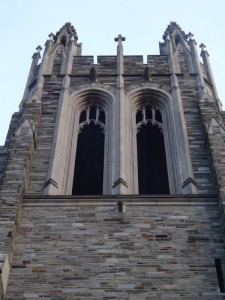
The Gothic architecture that can still be found on so many college and university campuses belies the secularism that has become ubiquitous in American higher education. Even the Catholic schools have had to tone down their sectarianism. But their commitment to the faith remains unshaken, and the priests and brothers who lead them would not have it any other way. Religious education classes may not be as common as they once were at these institutions but the chapels, religious murals, and men wearing collars (or in some cases women in habits) on these campuses make it clear that these are institutions rooted in Roman Catholicism. Nothing like this is still to be found at what were once Protestant campuses. If their religious roots remain on display, it is in the way they conduct themselves as humanistic institutions.
David R. Contosta, Ph.D., is Professor of History at Chestnut Hill College in Philadelphia. He is the author or editor of some twenty books, along with numerous articles and reviews. These include biographies of Henry Adams, Charles Darwin, and Abraham Lincoln, as well writings about religious institutions, higher education, urban and suburban history, and metropolitan parks. Several titles have focused on Philadelphia and Philadelphians. More recently Contosta has written, coproduced, and appeared in several documentary films. (Author information current at time of publication.)
Copyright 2014, Rutgers University
Gallery
Backgrounders
Connecting Headlines with History
